Where you see this button
Spider Collector's Journal (26th page: 2016) Copyright © 2016 by Rod Crawford
Here's the 26th page of narratives of fun (and not so fun)
trips to collect spiders for research at the Burke
Museum, some accompanied by capable field volunteers: Laurel Ramseyer, Ben Diehl, Jessi Bishopp. Most also appeared in Scarabogram, newsletter of "Scarabs:
The Bug Society." Dates of field trips head each paragraph. Maps showing
the location of sites within Washington state follow the grid system outlined
in the Washington
Spider Checklist. RETURN
TO INDEX
Where you see this button ![]() in a
field trip account, click it to get a page of collecting site photos!
in a
field trip account, click it to get a page of collecting site photos!
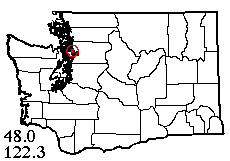 |
![]() 10 I 2016: The first trip of 2016 was another cold-weather excursion with Laurel and Ben Diehl. This time at least the sun was out and temperatures were more tolerable than our late-November misery trip to the shore of Hood Canal. Laurel and I arrived at Walter G. Hutchison Park, southern Camano Island, only slightly late (having admired a much-improved mountain snowpack on the way); Ben arrived from the north slightly later. This 5-acre forested park contains mixed forest with some sizeable hemlocks and cedars, plus groves of almost pure maple, and a small clearing (with tables) around the parking lot. There is a loop nature trail through several habitats. South along the road was a large open pasture; I started out sampling roadside conifers and grass along this stretch to take advantage of the sun warming things up, getting 5 species. Meanwhile, Laurel took 3 microspider species from park fences and other structures. Ben was sweeping fern understory, getting 10 worthwhile species. The only bird sounds were a raven's croaks.
10 I 2016: The first trip of 2016 was another cold-weather excursion with Laurel and Ben Diehl. This time at least the sun was out and temperatures were more tolerable than our late-November misery trip to the shore of Hood Canal. Laurel and I arrived at Walter G. Hutchison Park, southern Camano Island, only slightly late (having admired a much-improved mountain snowpack on the way); Ben arrived from the north slightly later. This 5-acre forested park contains mixed forest with some sizeable hemlocks and cedars, plus groves of almost pure maple, and a small clearing (with tables) around the parking lot. There is a loop nature trail through several habitats. South along the road was a large open pasture; I started out sampling roadside conifers and grass along this stretch to take advantage of the sun warming things up, getting 5 species. Meanwhile, Laurel took 3 microspider species from park fences and other structures. Ben was sweeping fern understory, getting 10 worthwhile species. The only bird sounds were a raven's croaks.
By midafternoon, air temperatures reached the mid-forties in the shade, so I decided to try a little sifting. Moss from 3 maple trunks yielded 8 spider species, and I got 6 more species from 2 bags of cold maple litter (not as cold as the last trip!). I took a third bagfull (from another spot on the trail) home to sift warmed-up, and this added 5. In all there were 12 litter spider species plus 13 other non-insects I collect, excellent for January. Laurel found some good spiders (including mature Callobius and Calymmaria) from 2 large rotting stumps; Ben got some worthwhile looking specimens from under logs, but unfortunately the vial fell out of his pocket somewhere back there in the woods! There were strange noises during the afternoon; innumerable bangs (possibly strings of firecrackers) and a horrible noise that sounded like parts of some huge rusty metal machine scraping together, but Laurel identified as jackasses in a pen beside the nearby pasture! The entire sunny Sunday, nobody but us visited this nice little park. I added a few species from non-fern understory, and then it was time to go and watch the sun set from the west shore of the island. We found 36-40 species to add to 2 homeowner-submitted records from nearby.
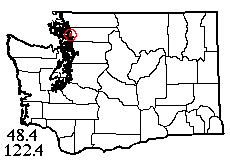 |
![]() 2 II 2016: There was a one-day window of dry collecting weather before the deluge. Laurel and Ben were both available (the site is only 15 minutes from Ben's home in Burlington) and I looked forward to a good haul. Our first destination was Padilla Bay Shore Trail, managed by Skagit County. Waiting at the parking lot (over a block from the trailhead), I got 2 species from conifers, while Laurel found a Blabomma under some discarded canvas and 3 more species from buildings (the Zygiella had retreats under paint flakes). Not too bad a start. Ben arrived, and we proceeded to the trailhead, where there was a biggish tract of sweepable grass – oops, sorry, it's a marsh and me without my rubber boots! Some marsh-side alder litter had one identifiable spider, non-native. We started up the trail (which threads between diked farmland and the bay) in hazy sunlight, the temperature inching up but still in the forties. I hiked on, looking for some decent sweeping, and finally found some but only got one identifiable species. Meanwhile, Laurel's sweeping added only one more; both Laurel and Ben turned shore rocks getting 5 species, all introduced and only one not taken already. Now, since I hadn't passed Laurel and Ben on the trail I got the impression they were ahead of me. So I hiked on rapidly (past No Name Slough) to catch them and turn them back. Thought I saw someone with a net, a quarter-mile ahead. But they evaporated, and I finally turned back after much more of a hike than I'd planned. Turned out I had passed the others and found them back at the car. By now we had only 11 spider species.
2 II 2016: There was a one-day window of dry collecting weather before the deluge. Laurel and Ben were both available (the site is only 15 minutes from Ben's home in Burlington) and I looked forward to a good haul. Our first destination was Padilla Bay Shore Trail, managed by Skagit County. Waiting at the parking lot (over a block from the trailhead), I got 2 species from conifers, while Laurel found a Blabomma under some discarded canvas and 3 more species from buildings (the Zygiella had retreats under paint flakes). Not too bad a start. Ben arrived, and we proceeded to the trailhead, where there was a biggish tract of sweepable grass – oops, sorry, it's a marsh and me without my rubber boots! Some marsh-side alder litter had one identifiable spider, non-native. We started up the trail (which threads between diked farmland and the bay) in hazy sunlight, the temperature inching up but still in the forties. I hiked on, looking for some decent sweeping, and finally found some but only got one identifiable species. Meanwhile, Laurel's sweeping added only one more; both Laurel and Ben turned shore rocks getting 5 species, all introduced and only one not taken already. Now, since I hadn't passed Laurel and Ben on the trail I got the impression they were ahead of me. So I hiked on rapidly (past No Name Slough) to catch them and turn them back. Thought I saw someone with a net, a quarter-mile ahead. But they evaporated, and I finally turned back after much more of a hike than I'd planned. Turned out I had passed the others and found them back at the car. By now we had only 11 spider species.
Our final destination (not literally) was nearby Bay View Cemetery. The temperature must have been close to 50 when we arrived, and I was able to sift maple litter, but it only added 5 spider species. Conifer foliage was hard to come by and only added one. But a number of planted juniper shrubs were much more productive, adding 8 species. Various other habitats we tried added only 2 more. Grand total, 27 species, with a high proportion of familiar non-natives. Some alder litter brought home to warm up, added no more. But it was a beautiful day, a pleasant seashore walk, and another spot on the map. Not every locality has outstanding spiders! And it was great to see snow on the foothills, like in the Good Old Days.
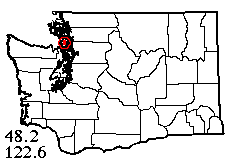 |
![]() 9 II 2016: Today was clear, dry and comparatively warm. And no drivers, thanks to work, an interview and the common cold. So I updated another Whidbey Island bus-ferry trip plan from last year. My goal was sites on the north side of Penn Cove, northern third of the 55-mile-long island. Something over 3 hours from home, Island Transit dropped me at the nearest bus stop and I hiked south to Monroe Landing beach park. An unpredicted fog (just now dispersing) had left all the grass dewy so I couldn't sweep the beach meadow until later, but I turned 50 pieces of driftwood without finding a single spider! Could have turned 500 if I'd cared to... Anyway, I hiked on along Scenic Heights Road to the next piece of public land; it was 98% mowed lawn. So onward to my main goal, the "Scenic Heights trust land," a county-owned habitat parcel of over 38 acres. The majority of this is a mowed grass field, too short to sweep except at the edges, but there are 2 good-sized areas of Douglas-fir. I squelched across the somewhat-soggy field to the first forest and found it surrounded by a dense, tall wild-rose thicket, with red hips and lots of nasty little spines. Fortunately a few wildlife trails penetrate this; unfortunately the thicket sharply limited my access to the forest-edge fir foliage. Moreover, there was no deciduous tree litter anywhere, and on my whole hike I'd passed no alders or maples, just a couple planted oaks in farmyards and a few fenced-in madronas. So I started collecting with a heavy handicap.
9 II 2016: Today was clear, dry and comparatively warm. And no drivers, thanks to work, an interview and the common cold. So I updated another Whidbey Island bus-ferry trip plan from last year. My goal was sites on the north side of Penn Cove, northern third of the 55-mile-long island. Something over 3 hours from home, Island Transit dropped me at the nearest bus stop and I hiked south to Monroe Landing beach park. An unpredicted fog (just now dispersing) had left all the grass dewy so I couldn't sweep the beach meadow until later, but I turned 50 pieces of driftwood without finding a single spider! Could have turned 500 if I'd cared to... Anyway, I hiked on along Scenic Heights Road to the next piece of public land; it was 98% mowed lawn. So onward to my main goal, the "Scenic Heights trust land," a county-owned habitat parcel of over 38 acres. The majority of this is a mowed grass field, too short to sweep except at the edges, but there are 2 good-sized areas of Douglas-fir. I squelched across the somewhat-soggy field to the first forest and found it surrounded by a dense, tall wild-rose thicket, with red hips and lots of nasty little spines. Fortunately a few wildlife trails penetrate this; unfortunately the thicket sharply limited my access to the forest-edge fir foliage. Moreover, there was no deciduous tree litter anywhere, and on my whole hike I'd passed no alders or maples, just a couple planted oaks in farmyards and a few fenced-in madronas. So I started collecting with a heavy handicap.
In all I got 4-5 species from the accessible fir foliage. Inside the forest, salal understory was better, producing 5 additional species. Much now depended on sifting, and what I had to sift was fir needle litter with tiny fallen rose leaves. It wasn't too bad, adding 5 more species, but big leaves would have been much better. Next, the fragments of a decayed log produced several spiders, but nothing new. On my way back to the road I swept the edges of the giant field but this only added 2 more species.
About halfway along my hike, I'd spotted some other habitats in an unfenced vacant land tract and decided to make a brief stop there going back. It's a good thing I did! There was fern understory here, and sweeping this for perhaps 10 minutes added 4 more species to my list! (Now including 4 species of Linyphantes). Finally, in my last hour before bus time, I worked on sweeping everything I could in and around Monroe Landing Park. It only added one more species, giving me my minimum goal of 21. Whew! I wanted to catch the 5:28 bus home so I couldn't stay at the beach until full-fledged sunset. However, I could see the sunset from a spot within sight of the bus stop. Six-plus hours of travel, 4.8 miles of road hiking, rose thorns, and a minimal sample. But I got outdoors on a beautiful day, saw new terrain, and learned more about the habitats of Whidbey Island – longest inland island in the USA (yes it is too!).
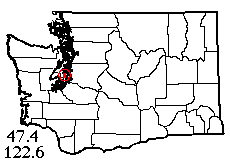 |
![]() 25 II 2016: Laurel and I took advantage of our annual week of late-February sun to visit Square Lake on the Kitsap Peninsula. It's an odd lake; maps disagree on whether it's round or quasi-square. Thanks to Google Earth's time-machine function, I found that it often shrinks to a round pond by mid-summer, but this time of year it always fills the larger straight-sided basin. The south part is in a state park (sort of; the state parks department pretends it doesn't exist) but the north end belongs to the adjacent "McCormick Woods" housing tract, reached by a short unmarked trail. Based on last year's visit to Big Pond on the other side of the "Woods" I predicted white pines, and I was vindicated! Enough white pines were scattered around to keep Laurel happily tapping cones, and oddly enough the dominant pine-cone arachnid was a neobisiid pseudoscorpion, with females either gravid or very well-fed (there were some spiders too).
25 II 2016: Laurel and I took advantage of our annual week of late-February sun to visit Square Lake on the Kitsap Peninsula. It's an odd lake; maps disagree on whether it's round or quasi-square. Thanks to Google Earth's time-machine function, I found that it often shrinks to a round pond by mid-summer, but this time of year it always fills the larger straight-sided basin. The south part is in a state park (sort of; the state parks department pretends it doesn't exist) but the north end belongs to the adjacent "McCormick Woods" housing tract, reached by a short unmarked trail. Based on last year's visit to Big Pond on the other side of the "Woods" I predicted white pines, and I was vindicated! Enough white pines were scattered around to keep Laurel happily tapping cones, and oddly enough the dominant pine-cone arachnid was a neobisiid pseudoscorpion, with females either gravid or very well-fed (there were some spiders too).
The north side of the lake is really far from straight, with 4 deep inlets. I settled at one (near where Laurel was cone-tapping) for collecting, expecting some deciduous litter but found very little. Shrub litter on the shady side gave me no spiders at all; shrub-madrona litter on the sunny side was better, with few spiders but 7 species. Next I spent time beating salal and evergreen huckleberry. The sun-exposed and forest-shaded shrubs had different spiders with a total catch of 12 species! The lake-shore marsh was very nice and added a further 5 species including Tetragnatha caudata. I could only access conifer foliage at one point, adding 2 species. In the marsh I found one lonely hummock of Sphagnum, but sifting it gave me no mature spiders; likewise with some nearby forest moss. Vegetation was reasonably natural, except for one holly tree. Squeezing by a dead but still limber branch from a log, it snapped back and hit me smartly in the knee! I'm surprised Laurel didn't hear me yell. I'm still limping a bit as I write this.
It was now latish afternoon so we did some exploring to find more habitats. Laurel found that the eastward trail ends at unbridged Square Creek. But just a short way down the west trail branch, I found a nice alder swamp at the head of another lake inlet. Here, there was a little litter but no additonal spiders were siftable. However, the moss on the alders was good, adding 4 species; Laurel swept the sedge (fresh and green here, though mostly winter-killed on the lake shore) adding Pachygnatha dorothea, and got some nice Cicurina tersa under dead alder bark. The day's final spider was Walckenaeria auranticeps beaten from fir foliage while hiking back to the car. Total catch, 32 species, best sample this month.
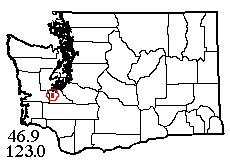 |
![]() 18 III 2016: We had the last winter trip of 2016 on a very springlike day. With Laurel in Europe and Jessi working, only Ben was available to drive; I picked a Thurston County site so he wouldn't have to backtrack after picking me up (he lives in Burlington, far north of Seattle). To be precise, Delphi Pioneer Cemetery, a very small cemetery nestled in a much larger tract of natural forest: ideal for spiders. While Ben got started on the understory, I beat some planted roadside firs for 8 species, half of them introduced. Ben's extended sample from the diverse understory eventually added 8 more. Sifting here was a bit sparse, but moss from maples and low branches added 5 species and maple-alder litter, 10 more. Turning over logs, Ben got both Antrodiaetus (an impressive big female) and Hexura, our two local mygalomorph (tarantula-like) genera. Sweeping a little roadside grass added Tiso vagans. With hours left to collect, we already had 35 species! Over the years I've found reason to be grateful to rural cemeteries for a number of prime collecting habitats.
18 III 2016: We had the last winter trip of 2016 on a very springlike day. With Laurel in Europe and Jessi working, only Ben was available to drive; I picked a Thurston County site so he wouldn't have to backtrack after picking me up (he lives in Burlington, far north of Seattle). To be precise, Delphi Pioneer Cemetery, a very small cemetery nestled in a much larger tract of natural forest: ideal for spiders. While Ben got started on the understory, I beat some planted roadside firs for 8 species, half of them introduced. Ben's extended sample from the diverse understory eventually added 8 more. Sifting here was a bit sparse, but moss from maples and low branches added 5 species and maple-alder litter, 10 more. Turning over logs, Ben got both Antrodiaetus (an impressive big female) and Hexura, our two local mygalomorph (tarantula-like) genera. Sweeping a little roadside grass added Tiso vagans. With hours left to collect, we already had 35 species! Over the years I've found reason to be grateful to rural cemeteries for a number of prime collecting habitats.
Next, we drove 2.8 miles SW into a working forest at the edge of the Black Hills, parking at a gated road I intended to hike up. What I didn't know was, a gravel pit on this road is set aside as a recreational target range: bang bang bang! Ben and I skirted behind the shooters and continued a half mile to a stream gully with maples, between planted clearcuts on one side and another, gun-free gravel pit on the other. A Douglas squirrel emerged from a small field of mossy talus rocks and posed for me; later I got adult Calymmaria under these rocks. Ben actually spotted skinks in the area! Fir foliage in and around the clearcuts got me 11 spider species (only 3 duplicating the cemetery catch) – and a deer tick, already active. Maple litter in the gully added 3 more; Ben's catch from roadside ferns had 2 additions. Roadside grass was very sparse but added 2 more. Ben's hunt for active wolf spiders added 2, including both sexes of Pardosa wyuta. Ben also added 3 more from under logs. In all, today's 2 sites gave us an astounding 56 species, more than any single field trip last year. Well worth "biting the bullet" and again edging behind the gunmen, still actively shooting at 6:30.
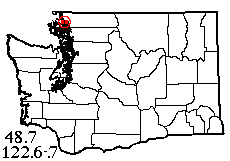 |
![]() 30 III 2016: Jessi Bishopp was available to drive and collect for the first time this year, hooray! Laurel, back from Europe, was also available. The three of us fulfilled a long-time plan of mine by visiting Lummi Island, located between the San Juans and the coast of Whatcom County. A short but pricey ferry ride brought us to the island dock (site of the island's only public restroom, be warned!) where we met Leslie Dempsey and Bremyhr MacLaren of the Lummi Island Heritage Trust. They guided us to our first site, on private land near the NW coast of the island, where I wanted to supplement an old 11-species sample from nearby Clark Island. The site, reached by a short hike up a dirt road (Blizard Road), was a big grassy field/meadow surrounded by varied natural forest. Though the field is sometimes mowed for hay, habitats here were in great shape and we got 23 spider species (more than I needed) in a short time. No extremely rare species here, but several that we never found in our 5-hour visit to the second site. I was just about to move on when I crossed a sandy dirt path and found it occupied by a very flourishing solitary bee colony. Laurel joined me in snapping bee photos and spotted a couple of bee-flies flinging their parasitic eggs into the bees' burrows.
30 III 2016: Jessi Bishopp was available to drive and collect for the first time this year, hooray! Laurel, back from Europe, was also available. The three of us fulfilled a long-time plan of mine by visiting Lummi Island, located between the San Juans and the coast of Whatcom County. A short but pricey ferry ride brought us to the island dock (site of the island's only public restroom, be warned!) where we met Leslie Dempsey and Bremyhr MacLaren of the Lummi Island Heritage Trust. They guided us to our first site, on private land near the NW coast of the island, where I wanted to supplement an old 11-species sample from nearby Clark Island. The site, reached by a short hike up a dirt road (Blizard Road), was a big grassy field/meadow surrounded by varied natural forest. Though the field is sometimes mowed for hay, habitats here were in great shape and we got 23 spider species (more than I needed) in a short time. No extremely rare species here, but several that we never found in our 5-hour visit to the second site. I was just about to move on when I crossed a sandy dirt path and found it occupied by a very flourishing solitary bee colony. Laurel joined me in snapping bee photos and spotted a couple of bee-flies flinging their parasitic eggs into the bees' burrows.
Next, we headed to the Heritage Trust's Curry Preserve (50 acres), which was a working farm not so long ago before the Trust acquired it, so the habitats are not in such great shape. Blackberry is almost everywhere, even though volunteers have cut down major thickets. The blackberry that remains doesn't really dominate any habitats, but it needs lots more work or it may do so someday. But it could be worse, at least we didn't see any ivy! We started up a forest trail from Tuttle Lane until we reached a large round former hayfield (the West Field) and mostly collected around there. Grass-sweeping produced varied spiders (introduced Tiso and Xysticus both prominent) with a Thanatus species, probably T. striatus, unusually common. Pardosa wolf spiders were active. A big detour took me around the field-edge blackberries to where I hoped to find litter under a couple of big maples. Well, I did find some litter but it was surprisingly sparse. I wonder if the deer (very common on the preserve) browse it, as they seem to do on nearby Orcas Island. Despite the sparse litter, sifting got me 9 species and bark on the ground yielded a couple more. Understory sweeping gave me uncommon Linyphantes eureka. While here, I heard a chainsaw somewhere NE of me, but blackberry in between kept me from investigating possible wood-poaching on the preserve.
Jessi had found an area with siftable moss on trees and logs down another trail, and this added 4 more species. Understory and cedar along other trails added a few more. Laurel and Jessi got a few introduced species in the public garden area near the old farmhouse; Laurel got the most interesting record of the trip here, third Washington record of introduced wolf spider Trochosa ruricola – then someone locked her in the fenced garden plot! After she escaped, we all met back in the west field to look for reachable Douglas-fir foliage, in very short supply due to the maturity of most fir trees and blackberry barriers around others. Laurel found the best fir branches, and between us we got 16 species from them, a very nice conclusion to a super-productive day; in all, we got 43 identifiable spider species from the Curry Preserve in about 5 hours. On the way back to the ferry we stopped briefly at the Congregational Church cemetery and beach trail, adding no more species but we got to see the Blizard family plot, proving that Blizard Road has nothing to do with snow!
 |
![]() 7 IV 2016: Our schedules made Thursday the preferred field day even though predicted highs up to 80 made most sites unappealing. So I picked the coolest, on the South Fork of Manastash Creek WSW of Ellensburg; at 3100 feet elevation this proved to be just inside the lower limit of melting snow, but with plenty of snow-free terrain to collect on. No trace of leaves yet on cottonwoods, vine maples and most shrubs. Plenty of leaf litter to sift, and I eventually got 9 species that way, including rare Cybaeus and Wubana species and the first Lepthyphantes furcillifer I've seen in a long time. I then got at least 8 species from conifer foliage, so I was sure of a full sample. Laurel and I both collected several active wolf spiders, but she got the only mature ones - three species, one specimen each!
7 IV 2016: Our schedules made Thursday the preferred field day even though predicted highs up to 80 made most sites unappealing. So I picked the coolest, on the South Fork of Manastash Creek WSW of Ellensburg; at 3100 feet elevation this proved to be just inside the lower limit of melting snow, but with plenty of snow-free terrain to collect on. No trace of leaves yet on cottonwoods, vine maples and most shrubs. Plenty of leaf litter to sift, and I eventually got 9 species that way, including rare Cybaeus and Wubana species and the first Lepthyphantes furcillifer I've seen in a long time. I then got at least 8 species from conifer foliage, so I was sure of a full sample. Laurel and I both collected several active wolf spiders, but she got the only mature ones - three species, one specimen each!
Meanwhile, Laurel had been reveling in her first day in Ponderosa pine country in several moons. Her first sample from 50 upland pine cones was really remarkable: 68 spiders and one pseudoscorpion, representing at least 18 spider species (mostly juvenile). Most numerous were male Xysticus locuples, which obviously were entering the cones to molt before ascending into their normal tree canopy habitat: there were just-molted males, penultimate males, and exuviae, all the evidence right there in the cones! Oddly the pine litter under the same tree had a different Xysticus species. Later (after a pause to remove a bunch of ants that had crawled up her leg) Laurel beat a second pine cone sample beside the stream, and a sample of relatively large Douglas-fir cones, both of which added more species. We got a few more from bare shrubs, pine bark, and rocks: total, 29 or 30. The sky was cloudless, temperature balmy but pleasant, melting snow patches feeding lots of little freshets, but most ground dry enough to walk on; altogether a great day, ending with Mountain High burgers that totally hit the spot!
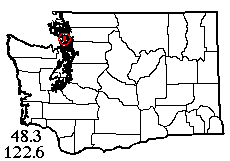 |
![]() 28 IV 2016: Weather and a lack of drivers had kept me out of the field most of April, but I wanted to get in at least one more trip before month's end, so I planned another bus-and-ferry Whidbey Island marathon. Everything was on time for a change, and I arrived at the end of the bus line on the Oak Harbor waterfront just after 11. First I wanted to add a few more species to the 8226 gridspace, whence I had a bare 21 species from February. Hal Ramaley Park, near the bus center, was mostly pavement and planters, but behind it was a grassy zone, only partly mowed. I quickly swept 4 species here and caught an egg-bearing Pardosa racing along. Across the road, the dugouts of park baseball diamonds added 3 more species. That mission was accomplished!
28 IV 2016: Weather and a lack of drivers had kept me out of the field most of April, but I wanted to get in at least one more trip before month's end, so I planned another bus-and-ferry Whidbey Island marathon. Everything was on time for a change, and I arrived at the end of the bus line on the Oak Harbor waterfront just after 11. First I wanted to add a few more species to the 8226 gridspace, whence I had a bare 21 species from February. Hal Ramaley Park, near the bus center, was mostly pavement and planters, but behind it was a grassy zone, only partly mowed. I quickly swept 4 species here and caught an egg-bearing Pardosa racing along. Across the road, the dugouts of park baseball diamonds added 3 more species. That mission was accomplished!
The gridspace to my north had no big public land chunks, but I'd located several city parks and a cemetery that looked OK in aerial views. First disappointment, Smith Park. From the air, completely covered with big shrubs or deciduous trees. From the ground, 100% lawns under one of Oak Harbor's last remaining Garry Oak stands. So, onward to Tyhuis Park which looks like a fir forest from the air. Nothing but lawn and tree trunks accessible there either! Along the east edge of town is a large tract of unused forest owned by the U.S. Navy. As I suspected, this was all fenced off and posted. However, across the road was a tract of undeveloped forest with no fences or signs. A faint path gave access – but not very far, and very dense understory prevented my reaching any good leaf litter. However, the salal foliage yielded a most satisfactory 9 species. Back at the road, I got 3 more from the Navy's fir branches growing out between barbed-wire strands, and a Salticus on an electric junction box. Now, on up the road to Maple Leaf Cemetery. Also rather disappointing; well-fenced around the edges so no access to any habitats but the well-groomed park shrubs, which added 3 more species. Sweeping the roadside verge along Regatta Drive got me practically nothing.
Now the hour grew late and my remaining options few. But I had one more park to try, very small Ridgewood Park in a residential backwater. Surprise! This one consisted entirely of natural habitats, all with nice spider fauna! After sweeping, sifting and tree-beating here, I had a nice safe 28-29 species. Hooray for Ridgewood Park, best park in Oak Harbor from a spider collector's standpoint! It was a long, long day and a 5-mile walk mostly on pavement, but worth it.
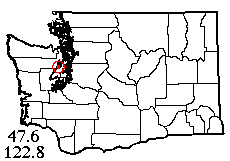 |
![]() 2 V 2016: Laurel was back in action after a trip and a cold, and we had one more day of heat before the weather became iffy, so we decided on Nick's Lagoon, Hood Canal coast of the Kitsap Peninsula, on the basis of a less-than-80 temperature prediction. This site, which recently (2008) became a county preserve, has its main feature, a pondlike lagoon fed by very small streams with a narrow outlet to Hood Canal, in reasonably good shape due to restoration efforts. The surrounding tidal marsh boasts the locally restricted species Hypselistes florens, found only in such habitats on the shore of Hood Canal within this state. We got 18 species in total in the shore area, with me sweeping the marsh and chasing wolf spiders while Laurel swept under the alders. Unfortunately we couldn't find any way to access the outer sandspit beyond the lagoon, where there are likely to be rare jumping spiders and others.
2 V 2016: Laurel was back in action after a trip and a cold, and we had one more day of heat before the weather became iffy, so we decided on Nick's Lagoon, Hood Canal coast of the Kitsap Peninsula, on the basis of a less-than-80 temperature prediction. This site, which recently (2008) became a county preserve, has its main feature, a pondlike lagoon fed by very small streams with a narrow outlet to Hood Canal, in reasonably good shape due to restoration efforts. The surrounding tidal marsh boasts the locally restricted species Hypselistes florens, found only in such habitats on the shore of Hood Canal within this state. We got 18 species in total in the shore area, with me sweeping the marsh and chasing wolf spiders while Laurel swept under the alders. Unfortunately we couldn't find any way to access the outer sandspit beyond the lagoon, where there are likely to be rare jumping spiders and others.
From that site, a trail leads through alder, cedar and maple to another point on Miami Beach Road (why the name, who knows). Though the mid part of the trail is flooded by a beaver pond, Laurel squelched to the end and reported good maple litter and moss there. I brought back bags of both to sift at the picnic shelter, blessing my rubber boots. The sifting only added 4 species. Back in the upland habitats of the preserve, along the driveway and near a mysteriously occupied house on the county parks property, we got enough species from understory, shaded conifers, Douglas-fir cones and a shed to bring the day's catch to 33 species, not bad at all; absence of mosquitos was another plus. However, someone really should attack the invasive blackberry that is liable to take over here if nothing is done.
I had spotted on the map a tiny, secluded cemetery in the neighborhood. Recent successful cemetery field trips inspired us to try the place out in the late afternoon. It was lucky we did! Seabeck Cemetery is almost unique in its complete absence of lawn. The trees were thinned somewhat but there are big conifers all over, and between them a thick growth of salal and other native plants, leaving only paths and graves actually cleared. Laurel says it's the most beautiful cemetery she's ever seen. There was even a pine tree, though she could only find 9 pine cones (with good spiders even so). The very different, drier environment here added 13 more species to our sample from the nearby lagoon, including an unidentified Philodromus from fir foliage and two unidentified microspiders from the salal. Our total for the day, 46-47 spider species total, not record-breaking but still excellent!
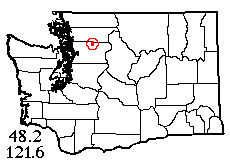 |
![]() 12 V 2016: Using a trip plan left over from last year, Laurel and I headed for Squire Creek Park just west of Darrington, a tract of nice mature forest along a creek as big as some rivers. Starting at a picnic shelter along the stream, I managed to sift 7 spider species from maple litter even though a veneer of mud on the leaves gave evidence of a flood surge over the winter. Moss on the trees added 4 species, a nice start! Meanwhile Laurel had gone to downtown Darrington to beat Douglas-fir cones in a park, adding one species. A second batch of fir cones by Squire Creek contained not one spider, however. Laurel did substantially better at the gravel bar and beach along Squire Creek, finding three species of Pardosa wolf spiders all mature at the same time! Park buildings added 4 more species. I had high hopes for the lush understory of the park forest, but that only added 2 more species. At this point we had 24 spider species and little hope of adding many more at this site.
12 V 2016: Using a trip plan left over from last year, Laurel and I headed for Squire Creek Park just west of Darrington, a tract of nice mature forest along a creek as big as some rivers. Starting at a picnic shelter along the stream, I managed to sift 7 spider species from maple litter even though a veneer of mud on the leaves gave evidence of a flood surge over the winter. Moss on the trees added 4 species, a nice start! Meanwhile Laurel had gone to downtown Darrington to beat Douglas-fir cones in a park, adding one species. A second batch of fir cones by Squire Creek contained not one spider, however. Laurel did substantially better at the gravel bar and beach along Squire Creek, finding three species of Pardosa wolf spiders all mature at the same time! Park buildings added 4 more species. I had high hopes for the lush understory of the park forest, but that only added 2 more species. At this point we had 24 spider species and little hope of adding many more at this site.
So, off in search of different habitats. A rodeo ground was a bit too well-groomed, and the Bluegrass Festival park was all fenced in. A public right-of-way down the road gave access to the Whitehorse Trail, former railroad, but it looked a bit similar to the Squire Creek habitat. However, the access road passed through a grassy powerline clearing that added 6 species from sweeping and a 4th wolf spider active on the ground. Near a Seattle City Light power substation building (which had one Salticus scenicus on the wall) were several Pinus contorta trees, but Laurel found the pine cones too dry here to yield much; they nonetheless added two species. The pine foliage had some nice stuff including mature Oxyopes scalaris and Phidippus johnsonii. While I collected in this area, a sheriff's police car came by and paused, watching me for about 10 minutes but the deputies never tried to talk to me. I could imagine an entertaining conversation taking place with their captain… Finally the law departed and for my final act I beat fir foliage along the access road, while Laurel got some good spiders from salal. Sustained effort brought us 41-42 species in this area.
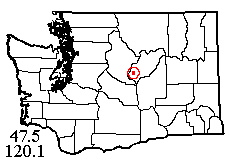 |
![]() 20 V 2016: Fulfilling a long-made plan, Laurel and I headed east on the long drive to Badger Mountain, abutting the Columbia River from the Douglas County side. Here is the biggest east-of-the-river stand of the Wenatchee Mountains population of Ponderosa pine. I'd selected an isolated square mile of state land, through which runs Rock Island Creek. Access was easy, and the creek crossing of Indian Camp Road featured an incredibly lush riparian community with meadows, shrub thickets, aspen, alder — and several isolated pine trees. Laurel immediately went for the pine cones, sampling 200 during the day from 4 selected trees in different sub-habitats, adding 4 spider species to our catch. The day was mostly cloudy with a few sun breaks and minor, harmless rain sprinkles; the site was incredibly peaceful with only the sound of the light wind, trickling stream and an occasional bird or insect. I started by sweeping a lush streamside grass meadow for 4 species. The meadow-edge shrubs added 4 more. Two wolf spider species were active here. Just outside the riparian zone was natural sagebrush steppe, but sagebrush foliage brought me only 3 more species. Anyway, now I had 13 species that I couldn't have got if the clouds had started raining on us.
20 V 2016: Fulfilling a long-made plan, Laurel and I headed east on the long drive to Badger Mountain, abutting the Columbia River from the Douglas County side. Here is the biggest east-of-the-river stand of the Wenatchee Mountains population of Ponderosa pine. I'd selected an isolated square mile of state land, through which runs Rock Island Creek. Access was easy, and the creek crossing of Indian Camp Road featured an incredibly lush riparian community with meadows, shrub thickets, aspen, alder — and several isolated pine trees. Laurel immediately went for the pine cones, sampling 200 during the day from 4 selected trees in different sub-habitats, adding 4 spider species to our catch. The day was mostly cloudy with a few sun breaks and minor, harmless rain sprinkles; the site was incredibly peaceful with only the sound of the light wind, trickling stream and an occasional bird or insect. I started by sweeping a lush streamside grass meadow for 4 species. The meadow-edge shrubs added 4 more. Two wolf spider species were active here. Just outside the riparian zone was natural sagebrush steppe, but sagebrush foliage brought me only 3 more species. Anyway, now I had 13 species that I couldn't have got if the clouds had started raining on us.
Now for litter sifting. There was litter near the meadow, but some was too dry and closer to the creek it was too sparse. Across the road was better litter - right in the dense wild rose thickets! I managed to get about 1 netfull of good litter and a couple more of less-good stuff, adding 5 species. A serendipitous pile of dead wood added 2 more; between us, we now had 24. Laurel was now done with her cones; she added one species from bark scales and helped me turn rocks, adding 3 species including an incredibly tiny male of the jumping spider Sitticus dorsatus.
Now we headed back down Badger Mountain Road, hoping for some house spiders at the new Badger Station firehouse, ironically at the site where the historic Beaver Creek School house burned down in 2011, leaving only an antique outhouse behind. Unfortunately the only house spiders were species we'd already taken, but I did sweep one more species from the grass. Now, two ravenous spider collectors descended on E-Z's Burger Deluxe in Wenatchee, then headed for home illuminated across the pass by an unusually long-lasting pink sunset.
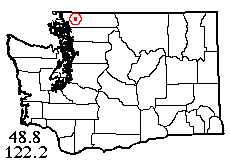 |
![]() 3 VI 2016: To fill in another blank in northern Whatcom County, Laurel and I stopped where the Public Lands map identified a Department of Wildlife parcel on the west bank of the Nooksack River, under the Mt. Baker Highway crossing. The site didn't seem much used, but it was accessible and had sweepable grass, beatable shrubs and trees, and siftable litter in spite of the encroaching blackberry. I swept 8 species from the fields, added 3 from the few available conifers, and sifted 6 from some productive (even though trash-contaminated) cottonwood litter, right next to a huge raspberry field. Meanwhile, Laurel beat a bunch of spiders (only one of them different from mine) from a ninebark bush, and added several from the boulder riprap along the river. Now we headed across the river, leaving my camera where I'd dropped it by the last patch of cottonwood litter (I recovered it later). Just for fun we thought we'd see if the giant gravel bar across the river from our first stop was accessible. It turns out that that area, on the east bank, is now the real official boat launch! A brief stop here added 4 more species from similar habitats, but nothing was active on the gravel bar in the hot sun.
3 VI 2016: To fill in another blank in northern Whatcom County, Laurel and I stopped where the Public Lands map identified a Department of Wildlife parcel on the west bank of the Nooksack River, under the Mt. Baker Highway crossing. The site didn't seem much used, but it was accessible and had sweepable grass, beatable shrubs and trees, and siftable litter in spite of the encroaching blackberry. I swept 8 species from the fields, added 3 from the few available conifers, and sifted 6 from some productive (even though trash-contaminated) cottonwood litter, right next to a huge raspberry field. Meanwhile, Laurel beat a bunch of spiders (only one of them different from mine) from a ninebark bush, and added several from the boulder riprap along the river. Now we headed across the river, leaving my camera where I'd dropped it by the last patch of cottonwood litter (I recovered it later). Just for fun we thought we'd see if the giant gravel bar across the river from our first stop was accessible. It turns out that that area, on the east bank, is now the real official boat launch! A brief stop here added 4 more species from similar habitats, but nothing was active on the gravel bar in the hot sun.
Now, another short hop brought us to the Bethany Lutheran Cemetery, right beside the highway in the hamlet of Nugents Corner. Laurel's eyes lit up at the sight of 2 planted Scots pine trees, but alas, she could find only one fallen cone! However, a nice variety of rich conifer foliage here added a couple of species (one a very unusual Philodromus), while Laurel got a nice Cyclosa under the trees and a very nice male Platycryptus on the church sign.
My intended last stop was on the far side of the gridspace, tiny Mud Lake right beside the busy highway. After finding a parking spot, I got out and walked up and down, back and forth, finding no reasonable way into the habitat that wasn't blocked by blackberry or a cliff. Fortunately, the side of the road away from the lake wasn't so bad and I beat several species, mainly introduced, from fern understory. For the last couple hours, I returned to the east bank river site to sift maple litter and moss, and beat some more understory (which wasn't so badly blackberried here). The litter wasn't as rich as on the west bank, but sifting still added 4 more species. While sifting, a chap walking his dogs stopped to chat and turned out to be a trained entomologist (Kurt Yandell) – now how often does that happen! He's now working as an innkeeper nearby, but has worked on insects with my friend Jim McIver in eastern Oregon. We left well before sunset with a 35-species sample where no spiders were known before.
 |
![]() 9 VI 2016: Appointments had kept Laurel at home during the sunny part of the week, so we had to go on Thursday where the only destination I could find with as little as 20% chance of rain was Liberty, a semi-ghost town in the south foothills of the Wenatchee Mountains, central Kittitas County. It was a case of give me Liberty or no trip at all. We started work at Liberty Meadows, a name often seen on photo captions but not on any map. It's a grassy (but overgrazed) meadow area west of Liberty townsite with scattered Ponderosa pines; pine-fir forest begins to the north. Sweeping the meadow grass got me absolutely nothing! (I did sweep one identifiable spider later on). So, I moved into the adjacent forest where I got 2 species under wood, 5 from Douglas-fir foliage. Heading back down to the meadow I did some pine foliage beating while 3 dogs from a nearby camp joined me – 2 rather yappy but the third, old, lame and half blind, very sweet. Between my and Laurel's beating (mainly hers) we got 8 species from pine foliage, best sample at the site and including uncommon Philodromus rodecki. Meanwhile, Laurel had been beating 100 pine cones from the isolated trees in the meadow, with a very uncharacteristic cone fauna of attractive little Steatoda of the fulva group - alas, none of them quite mature. They could be any one of three species, oh well. After the meadow site we had 16 species.
9 VI 2016: Appointments had kept Laurel at home during the sunny part of the week, so we had to go on Thursday where the only destination I could find with as little as 20% chance of rain was Liberty, a semi-ghost town in the south foothills of the Wenatchee Mountains, central Kittitas County. It was a case of give me Liberty or no trip at all. We started work at Liberty Meadows, a name often seen on photo captions but not on any map. It's a grassy (but overgrazed) meadow area west of Liberty townsite with scattered Ponderosa pines; pine-fir forest begins to the north. Sweeping the meadow grass got me absolutely nothing! (I did sweep one identifiable spider later on). So, I moved into the adjacent forest where I got 2 species under wood, 5 from Douglas-fir foliage. Heading back down to the meadow I did some pine foliage beating while 3 dogs from a nearby camp joined me – 2 rather yappy but the third, old, lame and half blind, very sweet. Between my and Laurel's beating (mainly hers) we got 8 species from pine foliage, best sample at the site and including uncommon Philodromus rodecki. Meanwhile, Laurel had been beating 100 pine cones from the isolated trees in the meadow, with a very uncharacteristic cone fauna of attractive little Steatoda of the fulva group - alas, none of them quite mature. They could be any one of three species, oh well. After the meadow site we had 16 species.
Next, we drove 3 miles up nearby Lion Gulch to a miner's campsite (unoccupied) at 3260' for a higher elevation fauna. My tree-beating here got 6 species, 4 different from the first site. Again, grass and flower sweeping in clearings added practically nothing. In the midst of the riparian forest was an actual creek, with lush shrub understory from which I swept at least 8 species. One bag of carefully selected alder litter got me 3 microspider species. Discarded lumber by a miner's carefully padlocked prospect pit added one. In the late afternoon one Pardosa species began running about. Meanwhile, Laurel tapped 50 more pine cones, this time with 3 identifiable species; she also got a nice big Gnaphosa muscorum under a rock and an even more impressive female of our large undescribed Novalena funnel weaver from a nearly inaccessible hole in a pine trunk. Off and on, we had brief spells of light rain from the cloudy skies (so much for 20% chance), but due to very great luck, the air was so dry that the foliage and my net never stayed wet for long. We left this site with 31-32 species.
We'd hoped to find some house spiders on the old plank buildings in Liberty town, but they were too darn clean! Still, we were able to get some photos of the picturesque place, and had plenty of time for burgers and shakes at Mountain High Hamburgers in Easton, where the rain was really coming down! Wouldn't you know it, it stayed dry in Seattle until evening…
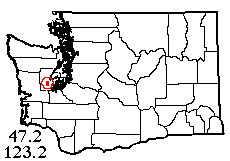 |
![]() 19 VI 2016: Ron Austin (Jerry's brother) wanted to get some video footage of a collecting trip, and no one else was available so it was just the two of us on the final spring field day. I selected two sites on Green Diamond timberland in Mason County (WNW of Olympia) because that area looked the driest in forecasted weather. That part worked out well, weather was sunny with hardly any water on the foliage from yesterday's rain. Our first goal was re-visiting my last spring's site on the west edge of Deckerville Swamp where I got two females of Washington's first Briggsus harvestman. I figured if I got about 10 more specimens they should include a male. Well, the leaf litter at the exact same site was far less productive in June than it had been in May; just a few spiders and no harvestmen. So I tried collecting from dead wood, not tried last year. This actually got me one (1) harvestman, and very few spiders. We'll have to see if the harvestman is a male after it's well enough preserved to dissect.
19 VI 2016: Ron Austin (Jerry's brother) wanted to get some video footage of a collecting trip, and no one else was available so it was just the two of us on the final spring field day. I selected two sites on Green Diamond timberland in Mason County (WNW of Olympia) because that area looked the driest in forecasted weather. That part worked out well, weather was sunny with hardly any water on the foliage from yesterday's rain. Our first goal was re-visiting my last spring's site on the west edge of Deckerville Swamp where I got two females of Washington's first Briggsus harvestman. I figured if I got about 10 more specimens they should include a male. Well, the leaf litter at the exact same site was far less productive in June than it had been in May; just a few spiders and no harvestmen. So I tried collecting from dead wood, not tried last year. This actually got me one (1) harvestman, and very few spiders. We'll have to see if the harvestman is a male after it's well enough preserved to dissect.
So, after minimal success at the first site, I wanted to sample a completely new gridspace farther east toward Shelton. The idea was to park at a Green Diamond gate and hike to Little Hanks Lake, using my last year's printout from Google Earth. Well, that photo didn't show all the roads; so by counting roads from the gate, we turned right one road too soon, and instead of Hanks Lake we came to a dried-up little pond where naturally we couldn't reach any water through the brushy forest buffer. Had I but known this at the time… Anyway, this first site brought me only 3 spider species so we hiked around, still trying to find water, and ended up in the "middle of nowhere" or really the middle of a large tract of regrowth from a 15-20-year-old timber harvest. A surprising number of lodgepole pines were in amongst the young Douglas-firs. (Yes, Laurel, I tapped 25 cones but got no spiders). This site had grass with flowering weeds to sweep (getting 5 species but it was hard work to get them), broom to beat (4 more species including rare Theridion differens), and lots of conifer foliage to beat (9 additional species). Around 4 pm I told Ron it was about time for wolf spiders to become active; then within seconds one ran in front of me! Wood fragments and bark slabs on the overgrown road added 2 more species including 2 very nice specimens of seldom-seen Callilepis pluto.
A final site along the hike back to the car added 2 species from salal, for 26 total. It was very hard work but despite not finding the lake, I managed to get a sample. I was also pleased to find that an old-geezer spider collector doesn't tire as quickly as a relatively young photographer! The trip home ran into some slow traffic but was otherwise unremarkable.
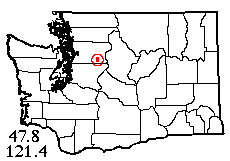 |
![]() 22 VI 2016: Jerry Austin, in possession of the family car, drove on the first field trip of summer; brother Ron tagged along in his own vehicle to get some more footage for his project. We went to a site I'd briefly visited last year, where the Index-Galena Road on the North Fork Skykomish River washed out (and how!) in 2006. The previous visit was aborted due to cold, wet conditions but this time everything was lovely. After a little sweeping of roadside verge (3 species) I spent a couple hours sifting the bushels of lovely moss on the riverside trees. This got me 8 species including only one linyphiid. Then I sifted some maple litter (2 bags) for no linyphiids at all, and only 2 species not in the moss. The largely-salmonberry understory got me only 2 more species, but lots of yummy berries. I'd set Jerry to turning rocks in the river bed; this got him nothing! But he added 4 species from miscellaneous vegetation across the river bed from me. By this time we had 19 species despite rather sparse pickings.
22 VI 2016: Jerry Austin, in possession of the family car, drove on the first field trip of summer; brother Ron tagged along in his own vehicle to get some more footage for his project. We went to a site I'd briefly visited last year, where the Index-Galena Road on the North Fork Skykomish River washed out (and how!) in 2006. The previous visit was aborted due to cold, wet conditions but this time everything was lovely. After a little sweeping of roadside verge (3 species) I spent a couple hours sifting the bushels of lovely moss on the riverside trees. This got me 8 species including only one linyphiid. Then I sifted some maple litter (2 bags) for no linyphiids at all, and only 2 species not in the moss. The largely-salmonberry understory got me only 2 more species, but lots of yummy berries. I'd set Jerry to turning rocks in the river bed; this got him nothing! But he added 4 species from miscellaneous vegetation across the river bed from me. By this time we had 19 species despite rather sparse pickings.
Now, Ron having departed, Jerry and I hiked up an old decommissioned forest road that follows Trout Creek up into the hinterlands, hoping to find stands of younger conifers with accessible foliage. That hope was vain, but this route was truly beautiful (after one eyesore pile of illegal dumping). It passes through extremely varied natural vegetation, alternating conifer and alder forests, constantly changing understory and verdant roadside herbs, all in the dappled early-summer sun and shade. Many windfalls had been cut by some public benefactor who hauled a chain saw all the way up there, to permit easy hiking along the old road (now a de facto trail). Why all this work? It turns out the trail eventually leads to the historic Sunset Mine. We stopped hiking well short of there because no new habitats were appearing, and backtracked to a site with Oregon-grape understory (this added 4-5 species with both of us sweeping) and finally a switchback where a little western hemlock foliage was reachable. The hemlock added one species, there was a Pardosa dorsuncata active on the road, and Jerry finally found spiders under a rock! (Zelotes fratris). He also spotted a redbacked salamander in an old stump that yielded no spiders.
The 26-28 spider species we got are enough to make a sample, but not what I might have expected from such a lovely area. Two causes: wrong season (early or mid spring, or fall, would have had more species), and the introduced Enoplognatha ovata dominating all the vegetation fauna, no doubt excluding many native spiders (and even some other non-natives). We were in time to stop at Zeke's Drive-in; my burger was one of their better efforts.
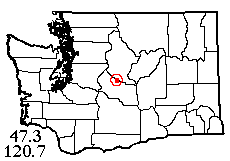 |
![]() 26 VI 2016: Now for another trip with Laurel Ramseyer, the Pine Cone Queen! Over Snoqualmie Pass (which we sort-of regretted later), our first order of business was to revisit Liberty Meadow, where the pine cone sample from June 9 yielded 14 specimens of a rare Steatoda – all juvenile! This time, Laurel's tapping about 20 cones from an adjacent tree got 8 more specimens, half of which had finally matured into Steatoda washona, hooray! The only previous Washington specimens are now at Harvard. Meanwhile I had tapped over 30 nearby cones and didn't get a single one; that's why she's the pine cone queen and I'm a mere cone drone.
26 VI 2016: Now for another trip with Laurel Ramseyer, the Pine Cone Queen! Over Snoqualmie Pass (which we sort-of regretted later), our first order of business was to revisit Liberty Meadow, where the pine cone sample from June 9 yielded 14 specimens of a rare Steatoda – all juvenile! This time, Laurel's tapping about 20 cones from an adjacent tree got 8 more specimens, half of which had finally matured into Steatoda washona, hooray! The only previous Washington specimens are now at Harvard. Meanwhile I had tapped over 30 nearby cones and didn't get a single one; that's why she's the pine cone queen and I'm a mere cone drone.
Now, the season being late enough for mountain sampling, we were off to the summit ridge of nearby Red Top Mountain, one of those rare places where you can drive to 5200' elevation. All the snow was long gone from this mountain and ridge. A handy network of trails allowed us to bypass the bare rocky peak with its fire lookout in favor of a subalpine meadow with flowers and sedge to sweep, firs (no hemlock here) to beat, and rocks to turn, with all producing spiders. Steatoda albomaculata was common under the rocks (where Laurel also found one Scotinella ant mimic); the trees produced one female of uncommon Philodromus mysticus. Large clouds periodically obscured the sun, leaving much of the sky blue. Now Laurel, hoping to escape the mosquitos, headed up to the summit where she added a Thanatus species hiding in a rock niche. Meanwhile, I backtracked into a treeline forest habitat where I hoped to find good spiders in conifer litter. But not one mature specimen! Mainly, a lot of juvenile Leptobunus harvestmen, which also dominated Laurel's fir cone sample from the meadow. However, dead-wood-tapping saved the day for me, adding 9 mostly-interesting species to the list including a third Steatoda species.
Now we descended partway down the winding mountain road to a lower trailhead (3800') where Laurel tapped 50 white pine cones while I swept roadsides and glades. Between us we added 6 species, for a 28-species gridspace total. Unfortunately, our luck took a turn for the worse when slow-creeping traffic plagued us from before Cle Elum nearly back to the pass. A very tired pair finally got home after 14+ hours on the go.
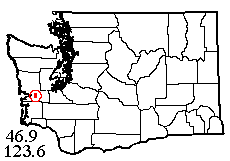 |
![]() 13 VII 2016: With the unseasonable July rain clouds finally clearing, Laurel and I headed southwest to Friends Landing Park, a Port of Grays Harbor property on the lowest reaches of the Chehalis river. A few miles inland from salt water, the tract is only 10-15 feet above sea level; road signs warn drivers "Don't Drown" in case of a flood. The park, quite a nice one, includes camping and other amenities but is mostly natural, with a lake (former gravel pit), a paved trail (for disabled access) all the way around the lake, and extensive swampy forest (alternating wet and dry, at least in summer) that is mostly deciduous but with occasional large Sitka spruces at our main collecting site. This habitat is different from anything I've ever seen in Washington, as lush, dense and impenetrable as the jungle in an old Tarzan movie. The air felt as humid as a jungle too, but fortunately not too hot and with few diurnal mosquitos. Uneven ground hidden by foliage added to the extreme difficulty of getting far off trail.
13 VII 2016: With the unseasonable July rain clouds finally clearing, Laurel and I headed southwest to Friends Landing Park, a Port of Grays Harbor property on the lowest reaches of the Chehalis river. A few miles inland from salt water, the tract is only 10-15 feet above sea level; road signs warn drivers "Don't Drown" in case of a flood. The park, quite a nice one, includes camping and other amenities but is mostly natural, with a lake (former gravel pit), a paved trail (for disabled access) all the way around the lake, and extensive swampy forest (alternating wet and dry, at least in summer) that is mostly deciduous but with occasional large Sitka spruces at our main collecting site. This habitat is different from anything I've ever seen in Washington, as lush, dense and impenetrable as the jungle in an old Tarzan movie. The air felt as humid as a jungle too, but fortunately not too hot and with few diurnal mosquitos. Uneven ground hidden by foliage added to the extreme difficulty of getting far off trail.
We set up to collect at the west end of the lake near its outlet, and saw only a few other trail users. (One passed Laurel, said "Bug Lady," then passed me and said "Bug Man!") I swept riparian meadow beside the outlet slough for 7 species, while Laurel only found a couple specimens in spruce cones. Laurel's spruce foliage beat added 5 species plus some nice big Nelima harvestmen; she got another species on the metal trail bridge. I got 4 more species from understory, sifted 3 more from moss and 2 more from the one pocket of leaf litter I could find that hadn't been flooded out, plus a quite nice Nearctodesmus millipede. Best spider at this site was Laurel's Theridion saanichum from spruce.
Now onward around the lake! Next stop was a floating dock where 5 of the 5 species duplicated the first site. At the edge of the campground was a nice riparian field that added one species, and a row of planted juniper shrubs that added 2 spider and one harvestman species; plus a male Poecilochroa montana on the asphalt walk! Behind the camp office building, Laurel beat Douglas-fir cones (adding one species) and we managed to collect 6 additional synanthropic species from buildings! One male Pholcus was in the ladies' shower, so it's fortunate I had "Bug Lady" along to enter and collect it. Finally we stopped at the boat launch where the river-edge meadows were very difficult to access, but I managed to get one additional Tetragnatha species. Oddly enough the river looked like it was flowing upstream! Tide, or just wind? Anyway, we had our sample now but it was 5:30 and we quailed at the prospect of Olympia-Tacoma traffic. So an extra hour spent on a back road, through somewhat similar habitat, added one more species for a total of 35-36. This park is a great spot and I'm glad I found it!
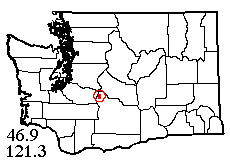 |
![]() 23 VII 2016: Now Laurel was hungry for real pine cones, and I had one remaining eastern-Washington location that might not be completely dried out yet: Union Creek Falls, just over Chinook Pass at 3500' elevation. At least the waterfall gorge should still be moist! We arrived at the trailhead after a brief stop at the forest hamlet of Greenwater, where Laurel sought in vain for her introduced crab spider Ozyptila praticola. A short hike brought us to the creek crossing, but where was the bridge? Before we doffed shoes to wade, I spotted a fairly substantial log crossing a little ways downstream. Closer inspection revealed a rope handrail, making it fairly easy to cross. On the far side, a rough track left the main trail heading for the base of the falls. Arrived there, I sifted one decent spider from a pile of bark chips and beat a few species from vegetation, while Laurel got 2 decent records from webs on the gorge walls and the trip's best spider, gnaphosid Callilepis eremella, active on the cobbles. I held out some hope for a decent-looking sample from dead wood, but it turned out to contain only 6 species, mostly common.
23 VII 2016: Now Laurel was hungry for real pine cones, and I had one remaining eastern-Washington location that might not be completely dried out yet: Union Creek Falls, just over Chinook Pass at 3500' elevation. At least the waterfall gorge should still be moist! We arrived at the trailhead after a brief stop at the forest hamlet of Greenwater, where Laurel sought in vain for her introduced crab spider Ozyptila praticola. A short hike brought us to the creek crossing, but where was the bridge? Before we doffed shoes to wade, I spotted a fairly substantial log crossing a little ways downstream. Closer inspection revealed a rope handrail, making it fairly easy to cross. On the far side, a rough track left the main trail heading for the base of the falls. Arrived there, I sifted one decent spider from a pile of bark chips and beat a few species from vegetation, while Laurel got 2 decent records from webs on the gorge walls and the trip's best spider, gnaphosid Callilepis eremella, active on the cobbles. I held out some hope for a decent-looking sample from dead wood, but it turned out to contain only 6 species, mostly common.
Meanwhile, Laural ascended the trail toward the 4000' elevation plateau above in search of pine trees. She did spot a few, but their cones on the steep slopes were nowhere to be found. I followed, and between us we got some very sparse pickings from grass, conifers and aerial webs. At this point, we both were counting on something better from the deep riparian forest by the trailhead!
Fortunately for Laurel, she located a very productive white pine tree by a footbridge over the creek (another, by a picnic table, had dropped only 3 cones!). The cones got her a reasonable sample with 4 identifiable species. I got the trip's only decent vegetation sample (5 species) from riparian understory there. But a cluster of cabins on the hillside above had no visible spiders on them. In all, just 24 species for our day's work, adequate but well short of what we'd hoped for. Time to start climbing mountains!
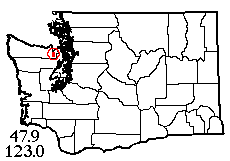 |
![]() 27 VII 2016: The Union Creek trip indicated that eastern Washington is getting too dry. Our next trip goal was therefore a moist area in the northeastern Olympic Mountains, with a mountain to climb: Mount Zion, 4260'. I had some roadside sites in mind to supplement the mountain spiders, but access was a problem, so I just collected in roadside habitats around the trailhead: 13 species including one adult Zygiella dispar that Laurel found on the outhouse (after I'd inspected same and missed it). Then it was time to head up the trail, and I do mean up! Parts were steep enough to remind us of last year's Mt. Ellinor hike (huff, puff). The forest isn't old growth but it's pleasantly natural and varied. We made only a couple of brief collecting stops on the way up, though noting spots for the walk back down, and in due course made it to the small rocky area at the summit. Here, I stopped to collect while Laurel took the (allegedly short) side trail to a cliff top with a better view. The conifer foliage and hemlock litter had spiders with a distinctly montane cast, adding nicely to the total. An old, weathered summit-ridge outhouse had quite a few more spiders than the new one by the road! Finally I decided we'd better start down if we wanted to hit those trailside sites on the way; but where was Laurel?
27 VII 2016: The Union Creek trip indicated that eastern Washington is getting too dry. Our next trip goal was therefore a moist area in the northeastern Olympic Mountains, with a mountain to climb: Mount Zion, 4260'. I had some roadside sites in mind to supplement the mountain spiders, but access was a problem, so I just collected in roadside habitats around the trailhead: 13 species including one adult Zygiella dispar that Laurel found on the outhouse (after I'd inspected same and missed it). Then it was time to head up the trail, and I do mean up! Parts were steep enough to remind us of last year's Mt. Ellinor hike (huff, puff). The forest isn't old growth but it's pleasantly natural and varied. We made only a couple of brief collecting stops on the way up, though noting spots for the walk back down, and in due course made it to the small rocky area at the summit. Here, I stopped to collect while Laurel took the (allegedly short) side trail to a cliff top with a better view. The conifer foliage and hemlock litter had spiders with a distinctly montane cast, adding nicely to the total. An old, weathered summit-ridge outhouse had quite a few more spiders than the new one by the road! Finally I decided we'd better start down if we wanted to hit those trailside sites on the way; but where was Laurel?
I started along the ridge trail to call her back from the views. And kept going, and kept going; Holy Ike, was this "short spur" going to be as long as the main climb to the summit? Finally I came to an array of 3 white-pine cones in mid-trail: a patteran, Laurel Ramseyer style! About 10 minutes farther along, I met Laurel returning from the more-distant-than-I-thought clifftop viewpoint, where she'd found a nice pair of Habronattus oregonensis jumping spiders on the bare outcrop. Her pine-cone sample had added 2 microspider species. We returned to the summit and headed down.
My main priority now was to find a spot with lots of dead wood chunks to collect log spiders from. Laurel insisted she'd seen a great log not far below the summit, so as we passed about 3 decent wood-collecting spots she would say "No, this isn't it; you'll like it, I promise you!" but in the end she couldn't recognize her log in the late afternoon light. However, she redeemed herself by spotting an adult Antrodiaetus folding-door spider right on the trail! Other highlights of the trip down included a Neriene radiata in her dome web, a big Callobius nomeus on a rock face, a satisfactory 4-species addition from fern and salal beating, and the one adult Metellina we saw — suspended in her sunlit orb high up in the forest gloom. I did finally get some dead-wood collecting, adding 2 more species including uncommon Arcuphantes arcuatulus. We headed back to the ferry, very tired but happy having bagged another peak and some 38 spider species.
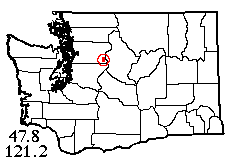 |
![]() 21 VIII 2016: Driver unavailability had kept me town-bound for nearly a month. Finally, with Laurel away in Michigan, Ron Austin was up for a Sunday trip to Evergreen Mountain (Beckler River drainage, central Cascades), a trip I'd had in mind since last year. At the end of a hot spell, Sunday was predicted as significantly cooler, a definite plus. We reached the area without trouble and stopped first at a creek crossing, 2600' elevation, for some non-mountaintop spiders. A half hour's sweeping and beating got me what I estimated at 13 species (it was really 10, but most of them not duplicated on the mountain). Eventually we reached the trailhead, and though I was turned around on the map and hiked a short distance in the wrong direction, we were on our way up the right trail in fairly short order.
21 VIII 2016: Driver unavailability had kept me town-bound for nearly a month. Finally, with Laurel away in Michigan, Ron Austin was up for a Sunday trip to Evergreen Mountain (Beckler River drainage, central Cascades), a trip I'd had in mind since last year. At the end of a hot spell, Sunday was predicted as significantly cooler, a definite plus. We reached the area without trouble and stopped first at a creek crossing, 2600' elevation, for some non-mountaintop spiders. A half hour's sweeping and beating got me what I estimated at 13 species (it was really 10, but most of them not duplicated on the mountain). Eventually we reached the trailhead, and though I was turned around on the map and hiked a short distance in the wrong direction, we were on our way up the right trail in fairly short order.
The first part ascends a 30+-year-old clearcut – very steeply, with several switchbacks at the vertiginous brink of near-cliffs. On the plus side, this section was full of in-fruit blue huckleberry bushes, helping me with some extra energy for the climb. Also one nice adult wolf spider crossed the trail and took a detour into my net. The trail grows less steep when it reaches the mountain's ridge crest, and soon after enters treeline old growth forest, just what I wanted. I stopped in a small forested saddle at 5150' elevation and started tapping wood and bark fragments for spiders. Ron took some footage of me, then headed on up to the lookout. In all I tapped 40 specimens and 11 species from wood, including such very-nice records as Oreonetides sp. #1 (not collected in a decade or more) and Poeciloneta canionis (first collected in Washington in 2012). Next I sifted 11 specimens from mountain hemlock litter, adding one more species. Meanwhile, clouds had moved in with a nice cool breeze; some might even have found it chilly, but it was fine for spiders and kept the flies off: really ideal weather for my purpose.
Now I ascended a little farther to treeline in order to sweep the vast summit-ridge meadow. Some stunning views up there! But the meadow was way past its prime and added no species. Ron rejoined me and I spent the remaining time beating true-firs at the forest edge, adding 2 more species including an unfamiliar Meioneta. Then it was time to head down, meeting one party ascending who hoped to stay the night. Light was getting dim when we reached the parking lot and there were still 5 cars there! I had 25 species from the trip, enough for a sample but a warning that summer field season is ending. In all it took an hour to get back to the highway, with a few brief rain sprinkles. As we headed west we could see a nice pink sunset at brief intervals (too brief to get a good photo). But better than sunsets, Zeke's Drive-in was actually open after dark for a change! Their burgers definitely go down well after climbing a mountain!
 |
![]() 19 X 2016: Three weeks of fall gone, all field-free due to weather and/or busy schedules. But finally Laurel and I slipped in a day between rainstorms, for a trip over Stevens Pass to the plain town of Plain (north of Leavenworth). I first planned to stop where the Chumstick Highway crosses a ridge-crest strip of Forest Service land, hoping Laurel could find pine cones galore. Well, the cones were there but they weren't open! While Laurel tried in vain to get a few spiders off solid cones, I beat 5 species off conifer foliage. Then we headed back down into the heart of Plain, hoping the "urban" pine trees would have better cones. They did, too! Still a lot of closed cones on the ground, but Laurel had little difficulty getting 50 open ones to sample for spiders. Result, 19 spiders of 11 species, 7 of them identifiable. Amazingly included was introduced Zodarion rubidum, found in western Washington for the first time earlier this year. Now here it is in this remote location; miles from the railroad too. Strange! I got a few more from roadside foliage and under objects behind a commercial building. Already up to 19 species, and 2 planned sites to go.
19 X 2016: Three weeks of fall gone, all field-free due to weather and/or busy schedules. But finally Laurel and I slipped in a day between rainstorms, for a trip over Stevens Pass to the plain town of Plain (north of Leavenworth). I first planned to stop where the Chumstick Highway crosses a ridge-crest strip of Forest Service land, hoping Laurel could find pine cones galore. Well, the cones were there but they weren't open! While Laurel tried in vain to get a few spiders off solid cones, I beat 5 species off conifer foliage. Then we headed back down into the heart of Plain, hoping the "urban" pine trees would have better cones. They did, too! Still a lot of closed cones on the ground, but Laurel had little difficulty getting 50 open ones to sample for spiders. Result, 19 spiders of 11 species, 7 of them identifiable. Amazingly included was introduced Zodarion rubidum, found in western Washington for the first time earlier this year. Now here it is in this remote location; miles from the railroad too. Strange! I got a few more from roadside foliage and under objects behind a commercial building. Already up to 19 species, and 2 planned sites to go.
So far the day had been sunny but cool. The sky now became hazier, but the air warmer. We crossed the ridge again and asked a landowner for collecting permission; his yes was so nonchalant, you'd think he had spider collectors every week. I had high hopes for the deciduous leaf litter here, but spiders in it were sparse indeed and only added one species. Laurel found non-native Scots pine in the yard, and the spiders in 30 tapped cones couldn't have been told from a similar sample around Puget Sound, but did add some species. We both swept extensive, rich tall grass fields (which attracted me to this property) and the sample looked great, but in fact only added 2 more species. The prize at this site was in a very sparse sample Laurel beat from conifer foliage: it contained the vanishingly rare, lovely little theridiid, Chrysso pelyx!
With 1.5 hours of daylight left, we headed back along the road to a bridge across the upper Wenatchee River at the mouth of Beaver Creek. Leaf litter here had similarly sparse spiders — but way more diverse than back in the Little Chumstick valley, adding 5 more species. One of us added one more microspider species at dusk under increasing overcast; 33 species total, better than I'd thought. The rain returned as we drove homeward through overcast gloom.
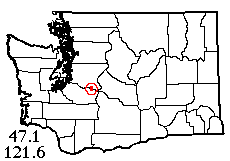 |
![]() 28 X 2016: The rainiest October in Seattle history was almost over, and one balmy day was predicted after a wet night. Despite the wet habitats, Laurel and I decided to go for it, and headed southeast to complete our partial sample at Greenwater, Washington (Cascade foothills, near the confluence of Greenwater and White Rivers) from this July. Wet pavement greeted us outside the Naches Tavern, although some south-facing slopes were drying in the warm sun. The wet caused Douglas-fir cones to close, and Laurel found only 40 she could tap for spiders, producing 2 identifiable species. I got 2 orbweavers from buildings and 3 more species from the few dry conifer branches. A lady at the tavern had set out a terrific row of carved pumpkins, which unfortunately didn't photograph well. After this slow start, we headed southeast for an 8-year-old clearcut at the junction of Forest Road 70, which we hoped was drying.
28 X 2016: The rainiest October in Seattle history was almost over, and one balmy day was predicted after a wet night. Despite the wet habitats, Laurel and I decided to go for it, and headed southeast to complete our partial sample at Greenwater, Washington (Cascade foothills, near the confluence of Greenwater and White Rivers) from this July. Wet pavement greeted us outside the Naches Tavern, although some south-facing slopes were drying in the warm sun. The wet caused Douglas-fir cones to close, and Laurel found only 40 she could tap for spiders, producing 2 identifiable species. I got 2 orbweavers from buildings and 3 more species from the few dry conifer branches. A lady at the tavern had set out a terrific row of carved pumpkins, which unfortunately didn't photograph well. After this slow start, we headed southeast for an 8-year-old clearcut at the junction of Forest Road 70, which we hoped was drying.
Arrived at the clearcut (where posted signs didn't forbid trespassing or spider collecting), I found the first habitat to dry was the Scots broom bushes, so I beat them getting 5 species. Grass in the semi-marshy spaces between trees and shrubs added little. The young Douglas-fir and hemlock trees produced 10 species, half of them already taken, but including a Philodromus that might be the rare P. shicki. Laurel swept verge along the road, adding 4 more including one microspider I can't figure out yet. Then we left this balmy but not-too-productive site and headed up the road to a bridge across the Greenwater River right at the edge of the gridspace. This site was shady and chilly, but the leaf litter (alder and cottonwood in 2 separate areas) was still warm enough to sift and added ten more species, plus assorted non-spiders.
I had one more selected site to visit before daylight ended: Slippery Creek, a tributary of the White River just west of Greenwater. All the land along the road was posted private with more restrictive signs, so we ended up back in the highway right-of-way, where there was plenty of maple litter within reach, some actually warmed up by the day's sun. Sifting maple litter added 7 more species not taken from the litter by the Greenwater River bridge. Then the sun sank behind the hills, and it instantly got too cold to sift! I tried some moss and got very little of what should have been in this rich habitat (but did add 2 species). A final bag of maple litter got me practically nothing, so it was time to give up! Meanwhile, Laurel added 2 more by sweeping along the highway. Despite suboptimal conditions (foliage in the forest never did dry), we got 43-45 species, making 48-50 with the earlier sample. It's hard to go wrong in the fall.
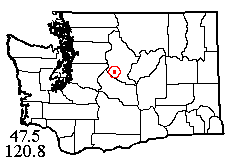 |
![]() 4 XI 2016: It was a rare, warm, dry day in November! Our first destination was canceled by a freeway blockage, and I suggested to Laurel that we might take this last opportunity to hit eastern-Washington pine-cone country. Later, I was sorry I talked her into it! We made it across the pass without incident, but conditions near Leavenworth appeared foggy and hazy. Worse, when we arrived at Johnny Creek Campground, vegetation and leaf litter were as wet as if it had rained hours, not days before. However, I set up at a sunny picnic table to sift vine maple litter, which produced very few spiders (good ones though, and 8 species). Meanwhile, Laurel got quite a nice 7-species sample from camp buildings and signs. She went hunting pine cones while I switched to cottonwood litter, as the sun disappeared behind the mountains.
4 XI 2016: It was a rare, warm, dry day in November! Our first destination was canceled by a freeway blockage, and I suggested to Laurel that we might take this last opportunity to hit eastern-Washington pine-cone country. Later, I was sorry I talked her into it! We made it across the pass without incident, but conditions near Leavenworth appeared foggy and hazy. Worse, when we arrived at Johnny Creek Campground, vegetation and leaf litter were as wet as if it had rained hours, not days before. However, I set up at a sunny picnic table to sift vine maple litter, which produced very few spiders (good ones though, and 8 species). Meanwhile, Laurel got quite a nice 7-species sample from camp buildings and signs. She went hunting pine cones while I switched to cottonwood litter, as the sun disappeared behind the mountains.
Now our luck seemed to be out. Laurel discovered that all available pine cones were closed, as with our previous trip to Plain. And I just could not get any spiders from cottonwood litter! True, it was wet, but not wetter than last week's very productive Greenwater River sample. And it couldn't have been the cold, because a bag I brought home and warmed up gave the same result. Not just frustrating, but also strange! After Laurel added 2 species from pine bark scales, we tried beating vegetation, much of which was still borderline wet (good thing I brought a spare net). Grand fir and spruce foliage had no spiders! Even Douglas-fir gave me only 2 species. Meanwhile, Laurel got only one mature species from shrubs, Pimoa curvata which shouldn't even have been in that habitat…
As dusk approached, we tried a second site, up a decommissioned road on Mac Creek a quarter mile down-canyon. I did spot a couple of partly-open pine cones here, but Laurel was too discouraged to even try them. One steep hillside was littered with promising-looking wood chunks; they yielded no spiders! Moss, litter and shrubs here were too wet. Conifer foliage added 2 species. In the end, we had 22-23 species from the area including some unusual or unfamiliar ones, so we didn't waste our day. But still, what strangely poor habitats!
That wrapped up 2016, remaining weather too wet. Stay tuned for 2017!
This page last updated 21 March, 2025